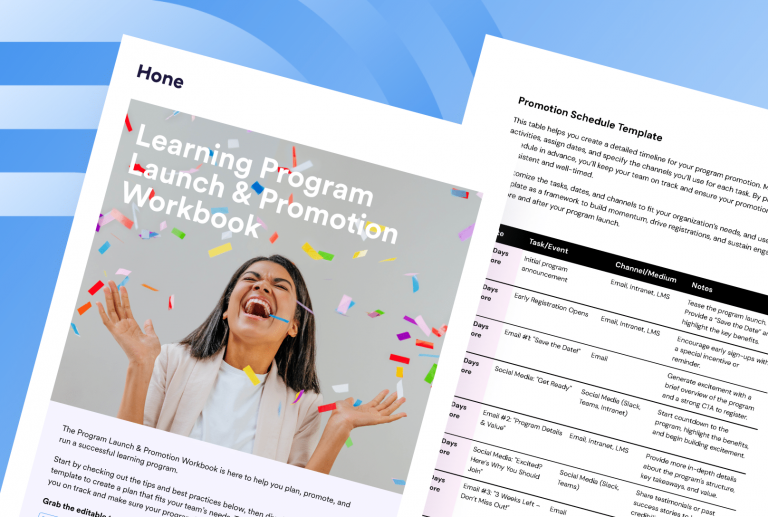What is Learning Retention?
The definition of learning retention refers to a person’s ability to transfer new information into their long-term memory. Retention allows learners to recall and put knowledge to use in the future.
4 factors affecting learning retention
- Interest and Motivation – A learner’s interest and motivation influence learning retention. Learners often retain information for a long time when interested and motivated because the human brain tends to focus more.
- Repetition – Repetition of the learning material reinforces learning retention. The more an individual repeats or practices a task, the better they retain it in their memory.
- Association – Paying attention to the meaning and significance of the content or associating it with real-life scenarios helps individuals learn quickly and retain the information longer.
- Use of Multiple Channels – Different people prefer different learning styles, such as instructor-led vs. hands-on vs. visual cues. Therefore, choosing the appropriate learning method or technique is important to boost learning retention.
The learning pyramid or cone of learning below lists various learning methods and their expected retention percentage:
- Lecture – 9%
- Reading – 10%
- Audio/visual – 20%
- Demonstration – 30%
- Discussion group – 50%
- Practice by doing – 75%
- Teaching others – 90%
Learnings retention’s importance for L&D and HR Leaders
Learning and development (L&D) and human resource (HR) leaders are vested in what happens after the learning event. However, one of the leaders’ most significant challenges is the “forgetting curve” when course participants do not remember what they learned.
According to the Ebbinghaus Forgetting Curve, learners can forget:
- 60 percent within 20 minutes of the training experience.
- 70 percent within 24 hours of the training experience.
- 80 percent within 31 days of the training experience.
With deliberate and effective retention support, participants will remember and apply learning objectives in the workplace. From the start, performance support tools must be part of the L&D strategy and budget.
Continuous learning in the workplace is a retention strategy. A progressive workplace learning strategy builds upon previous classes and training programs to encourage employees to truly embrace, retain and expand knowledge over time. One-off L&D initiatives are less successful than having an ongoing learning mentality.
What is Employee Performance?
The definition of employee performance is how a staff member fulfills their role’s duties, completes required tasks, and behaves in the workplace. Performance measurements include the quality, quantity, and efficiency of work.
Employees’ performance is a company’s greatest asset. Therefore, investing in their training and development is key to sustaining business growth and success.
Studies show that organizations that invest in employee development experience:
- Increased sales and higher profits.
- Improved productivity and workplace engagement.
- Increased job satisfaction and morale.
- Higher company interest (i.e., Attract top talent).
- Improved employee retention.
- Stronger workplace relationships and peer collaboration.
Learning new knowledge and skills improves organizational performance and increases employees’ value. But learning retention is necessary to apply further information and abilities. Dedicated L&D initiatives and support systems foster employee engagement and an efficient and competitive workforce.
5 factors affecting employee performance
1. Employee Engagement – Engagement affects productivity, and increased engagement leads to higher performance and profitability. Factors that increase employee engagement include:
- Feeling acknowledged and appreciated for their contributions
- Team collaboration within and outside their department
- A sense of community among team members and the company
2. Training and Development – Employees feel encouraged by an organization that supports their development to improve their skills. This support starts with training new hires to fulfill their positions and continues with ongoing learning initiatives.
3. The Right Tools for the Job – Individuals need the proper tools to perform their tasks and excel in their positions. Tools include office supplies, a fast and reliable internet connection, and hardware and software upgrades.
4. Company Culture and Work Environment – Company culture sets procedural and behavioral norms within an organization, including policies, goals, attitudes, and expectations. The work environment plays a significant role in productivity. Employees need a clean, safe, and comfortable place to conduct business. Likewise, the organization’s learning climate and environmental factors can impact training success and retention.
5. Clear Targets and Goals – Performance goals must be specific, measurable, achievable, relevant, and time-bound. SMART goals ensure that employees know what is expected of them, how they will do it, and the expected duration to take.
3 Best Practices for Learning Retention and Employee Performance
- Reinforce learning and encourage learners to apply knowledge and skills in the workplace.
- Demonstrate an ongoing commitment to participants’ success to extend engagement.
- Track and measure participation and performance data after the conclusion of an event.
Learning retention strategies
The best learning retention strategies to promote employee performance involve practices during and after the learning event. For instance, incorporating active learning practices increase the retention and transfer of new information. Likewise, ongoing training and development opportunities reinforce learned knowledge and skills.
Evidence-based strategies support ongoing learning, and most involve practice distributed over time. A learning retention or reinforcement initiative creates room for reflection and encourages applying new knowledge, skills, and tools. With support after a learning event, participants will remember much of what they learned and more easily overcome other barriers to transfer learning to improved performance.
Additionally, a supportive learning environment promotes retention. A 2020 Workplace Learning Report from LinkedIn highlighted that 42% of global L&D professionals noted a need for a learning culture in corporations.
4 effective training methods
- Interactive and engaging content – Trainers can bump learning retention statistics by creating interactive and engaging content, such as adding personality, honesty, or well-placed humor to drive home key points. Create a narrative with situations and characters that employees can relate to. Craft animation videos to illustrate complex processes interactively and include interactive quizzes and surveys. Make the content relevant to the job and use eye-catching visuals. For example, trainers can ask questions that relate to essential and tangible learning points. Participants are less likely to engage with learning points that are abstract or circumstantial.
- Apply learning to the real world – Learners more easily remember things that relate or are relevant to their environment or needs. Learning that is directly applicable to their professional lives helps them understand how training will impact their work. Simulations demonstrate how learning objectives apply to the real world. Before using their new skills, they can see the benefits or consequences in a risk-free environment.
- Blended learning – Blended learning combines the best training methods. Some examples of blended learning are the combination of traditional face-to-face learning with eLearning, cohort groups with autonomous learning, and a fixed schedule with an a la carte model.
- Spaced learning – Instead of one-time learning events, spaced learning breaks down training programs into several sessions or modules of shorter durations with spaced intervals. It reintroduces sessions multiple times over a few days or weeks for learners to recall and retain information long-term. It also provides the added benefit of minimizing the loss of knowledge that occurs with one-time learning by repeating learning after certain intervals.
3 Reinforcement Techniques
- Repetition – Participants are more likely to retain training when required to recall information in the hours and days following. An individual will better remember training the more they repeat or practice tasks.
- Teaching others – Participants who assist peers, discuss what they learned with colleagues, or participate in online discussions reactivate what they learned. It reinforces their learning by engaging the learning material enough to explain it clearly to others. Further, it helps learners retain more information by interacting with the material in new and creative ways.
- Learning during the workflow – Learning during the workflow means accessing answers or learning material in the moment of need. New knowledge, skills, and tools bridge the gap between learning and doing when it remains visible, present, and always on in the system’s employees use daily.
Measurement and Evaluation of Learning Retention
Assessments administered at the start and finish of the program demonstrate learning gains among participants. L&D leaders can also note the behavior change differences in the workforce before and after training.
However, stakeholders often want to see the return on investment (ROI) in the form of business impact. As a result, most businesses have frameworks to track team and individual performance, including OKRs, KPIs, etc.
These goals and metrics measure success and instill accountability, and L&D leaders can use them to show how training leads to those work performance objectives.
3 Employee Performance Strategies
- Setting performance goals and expectations – Goal setting goes hand-in-hand with learning and development. The need to build a specific skill set often follows individual and organizational goals. Performance goals and expectations identify a measurable gauge and target.
- Providing feedback and coaching – Workplace coaching is when a more experienced or skilled individual helps others improve their performance and achieve their professional goals. This structured and collaborative approach develops their skills, knowledge, and abilities.
- Recognition and rewards programs – Incentives, recognition of performance, and acknowledgment of contributions reinforce positive behaviors. The credit or reward celebrates employees meeting goals or embodying core values.
What’s the connection between learning retention and employee performance?
Employee training creates a win-win scenario for the participants and the organization when done well. Individuals learn new skills and build on existing ones, which, in turn, improves their performance and makes them more productive.
Learning retention extends employee engagement and can improve organizational performance. Training participants who retain learned information demonstrates a commitment beyond classes, workshops, and other modules. Conversely, if participants do not include the knowledge over time, they have not really learned.
Further, learning retention programs can deliver important information about needed changes to learning events and documents to make outcomes more successful.
How do you use analytics to measure the impact of learning retention on employee performance?
Training professionals must construct impact studies that look before and after training, prove the value, and explain the tremendous benefits clearly and in great detail. When verifying the ROI of L&D initiatives, leaders must evaluate the behavior change and business impact.
- Are participants doing anything differently or better on the job?
- Do they do something more efficient?
- Did they improve the critical skills that were taught in training?
- Did training improve the performance metrics and indicators that matter to the business?
- What was the increase in productivity, sales revenue, customer satisfaction, or other tangible benefits to the business?
Behavior change is a metric that measures the extent to which participants return to their everyday jobs and apply what they learned in training. Equally, the business impact is how much of that improvement is directly attributable to the specific training program.
Additionally, these measurements must continue past the immediate end of training. So, leaders must do assessments months after the learning concludes to allow time for transfer and effect.
The metrics Hone measures are improvements in the key behaviors and skills taught in training. Each class is closely aligned with critical skills and behaviors. The on-the-job improvements are captured 60 days post-training.
Integrate Learning Retention and Employee Performance Strategies to Maximize Impact
Training needs deliberate and effective learning retention support to reinforce and apply learning objectives in the workplace. To make the most of a learning experience, designers and facilitators need to integrate retention and performance strategies.
Those with a role in designing, developing, or delivering learning events can get more value from professional development, capacity building, and training investments by strengthening learning retention.
For example, participants should deduct responses to easy-to-understand questions that illustrate applying the knowledge in real-life situations. This boosts employee engagement and increases the application of knowledge and skills while encouraging achieving results and organizational goals.










